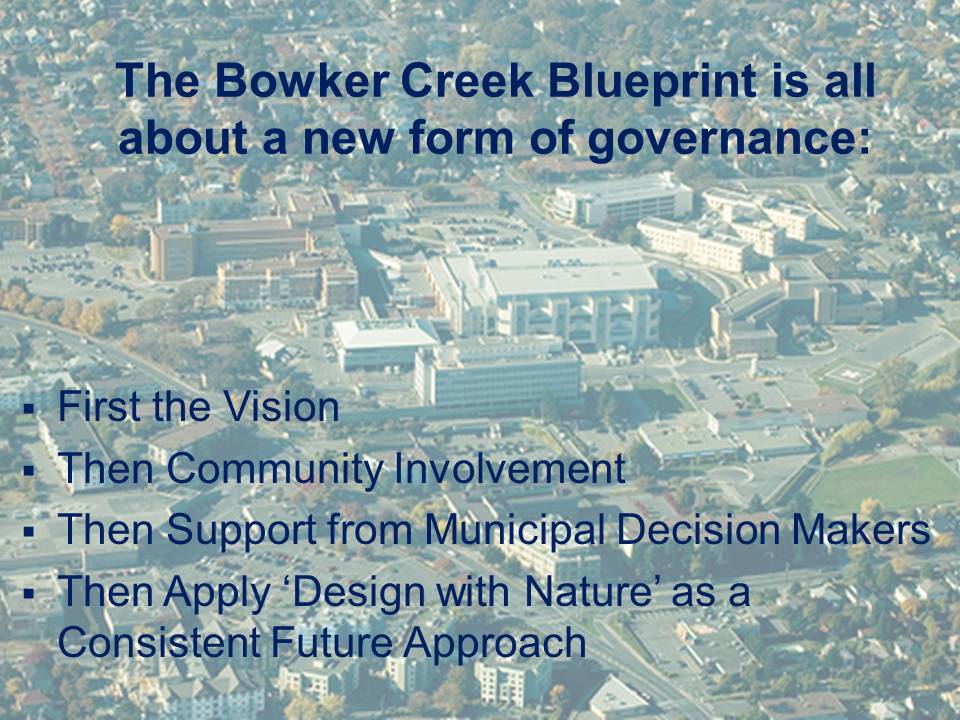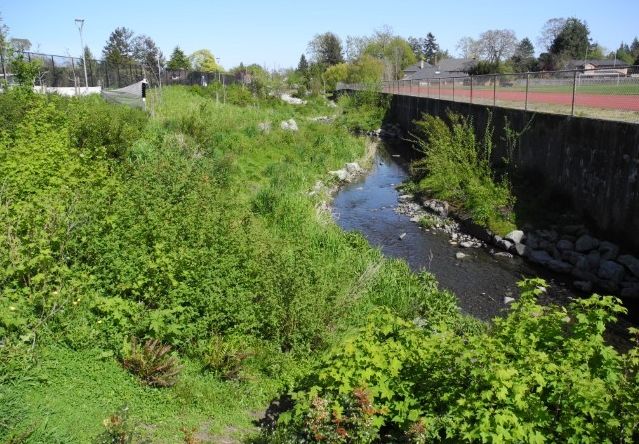BOWKER CREEK RESTORATION IS A BEACON OF HOPE: “Agree on the vision. Set the targets. Provide planners with the detail necessary to guide site level decisions as opportunities arise. Then implement,” urges Jody Watson, Capital Regional District (Module C on Day Two of the Parksville 2019 Symposium – a presentation on moving towards restorative development)
Note to Reader:
Teamwork for the common good is a powerful and often transformative experience, particularly when a longer term vision for a local creekshed engages multiple interests, disciplines and local government. Collaboration taps into the passion and ingenuity of volunteers who are driven by commitment.
On Vancouver Island, the Bowker Creek restoration initiative is a “beacon of hope”. A provincially significant precedents, it has a long history in demonstrating how local government partnerships with stewardship groups can “improve where we live”. The Bowker Creek restoration story is inspirational.
Many watersheds have a base document called an Integrated Stormwater Management Plan, known as an ISMP. The Bowker Creek Blueprint: A 100-year action plan to restore the Bowker Creek watershed, is the Bowker Creek Initiative’s unique version of an ISMP. It is a document that sets out watershed principles and specific actions that balanced the social, economic and environmental factors of urban watershed renewal.
At the Parksville 2019 Symposium, Jody Watson, Past-Chair (2004-2018) of the Bowker Creek Initiative, tells the story of the community effort it is taking to bring life back to Bowker Creek.
Bringing Bowker Creek Back to Life in the Capital Region: Community Buy-In is Key
Bowker Creek flows through three municipalities: Saanich, Victoria and Oak Bay. Degraded over generations, and buried for much of its length, Bowker restoration demonstrates how a good strategy is the path to success. The Bowker Creek Urban Watershed Renewal Initiative serves as a how-to-guide for a ‘top-down & bottom-up’ approach. Connect with the community and get the vision right.
 “Our collective ‘baseline’ or memory of what a healthy creek should look like has shifted significantly,” states Jody Watson, Capital Regional District. Jody is Supervisor, Environmental Partnerships & Initiatives. Now Past-Chair, Bowker Creek Initiative, she provided strong leadership for a decade and a half (i.e. from 2004 through 2018).
“Our collective ‘baseline’ or memory of what a healthy creek should look like has shifted significantly,” states Jody Watson, Capital Regional District. Jody is Supervisor, Environmental Partnerships & Initiatives. Now Past-Chair, Bowker Creek Initiative, she provided strong leadership for a decade and a half (i.e. from 2004 through 2018).
“Within the urban environs, this baseline had shifted even more through generations of development and decades of engineering practices designed to get the water off the land as quickly as possible. This approach to land development has resulted in a loss of hydrological and ecological function in many areas.
“The multi-jurisdictional nature of our watersheds requires the collective commitment of local and senior government agencies, First Nations, and communities to improve the health of our watersheds. Utilizing a ‘Design with Nature’ approach (in Bowker Creek), we are changing the way we develop our land by attempting to re-engineer the hydrological function back into our urban landscape. We are, in some ways, cultivating a new land ethic.”
A Blueprint for Action
A decade in the making, and approved by all three municipalities as of 2012, the Bowker Creek Blueprint: A 100-year action plan to restore the Bowker Creek watershed resulted from a unique multi-jurisdictional effort. Outreach proved to be a powerful tool for building community and political support.
The Bowker process demonstrates that four ingredients are essential for a successful creekshed restoration strategy, namely – champions inside and outside government, broad-based collaboration, perseverance by individuals in all walks of life, and sustained commitment over decades by local governments. Ultimately, Bowker Blueprint implementation hinges on embedding details into operational work plans. This is happening.
Recognition
In a presentation to Capital Regional District elected representatives in February 2014, Kim Stephens (Executive Director, Partnership for Water Sustainability in BC) stated that:
 “I really want to highlight the significance of the Bowker Creek Watershed Blueprint. In a word, it was a game-changer. It is a game-changer. It continues to be a game-changer. And it is provincially significant and precedent-setting. It is also inspirational. In my 40-year career as a professional engineer, there is nothing that equals it. And the reason it is so important is that it gave the rest of us a vision of what can be. In this region, you moved it from just having reports to actually having action.”
“I really want to highlight the significance of the Bowker Creek Watershed Blueprint. In a word, it was a game-changer. It is a game-changer. It continues to be a game-changer. And it is provincially significant and precedent-setting. It is also inspirational. In my 40-year career as a professional engineer, there is nothing that equals it. And the reason it is so important is that it gave the rest of us a vision of what can be. In this region, you moved it from just having reports to actually having action.”

A Watershed Moment
Replacement of the old Oak Bay High School with a new facility created the opportunity for a flagship creek restoration project. Completed in 2015, this has been a catalyst for action – for example, the Bowker Creek Developers’ Guide, in collaboration with the Urban Development Institute.
“Channel restoration at Oak Bay High was a true ‘watershed moment’ for the creek and the community. It is a wonderful example of how a long-term coordinated plan to restore function to a degraded watershed can happen, piece by piece, and when opportunities arise, when we work together towards a common vision,” notes Jody Watson.
“The Bowker Blueprint is the outcome of a landscape-based and action-oriented process. It is a truly integrated plan to restore watershed function over time. Agree on the vision. Set the targets. Provide planners with the detail necessary to guide site level decisions as opportunities arise. Then implement.”
To Learn More:
Visit the home page for the 2010 Bowker Creek Forum on this Vancouver Island community-of-interest.
Download Bowker Creek Blueprint: A 100-year action plan to restore the Bowker Creek watershed
Read Oak Bay High School’s outdoor classroom at Bowker Creek opens (2016).
Read The 100-year plan to restore Bowker Creek (2018)

Bowker Creek Channel Restoration at Oak Bay High School

